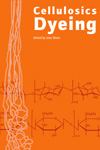Wednesday, October 28, 2009
Heterocyclic Polymethine Dyes
Sunday, October 25, 2009
Monday, October 19, 2009
Analytical electro chemistry in textile
Color Phyics For Industry
Friday, September 25, 2009
Wednesday, September 9, 2009
Cellulosic Dyeing By John Shore

Cellulosic Dyeing By John Shore

Textbook of Practical Organic Chemistry (5th Edition) A.I. Vogel, Vogel's Textbook of Practical Organic Chemistry (5th Edition)
Prentice Hall | ISBN: 0582462363 | 1996 | HTML & PDF | 1552 Pages

Textbook of Practical Organic Chemistry (5th Edition) A.I. Vogel, Vogel's Textbook of Practical Organic Chemistry (5th Edition)
Prentice Hall | ISBN: 0582462363 | 1996 | HTML & PDF | 1552 Pages

Sunday, September 6, 2009
Cellulosics Dyeing Edited by John Shore
 Cellulosics Dyeing
Cellulosics Dyeing Edited by John Shore
The most thorough book available for those interested or involved in the dyeing of cellulosic fibres. It gives detailed coverage of the theoretical and practical aspects of preparation and dyeing, and how the properties of the fibres and dyes influence the coloration behaviour.
Published by the Society of Dyers and Colourists
Contents
| Chapter 1 | Cellulose - structure, properties and behaviour in the dyeing process, by Thomas P Nevell |
| Chapter 2 | Preparation, by William S Hickman |
| Chapter 3 | Dyeing with direct dyes, by John Shore |
| Chapter 4 | Dyeing with reactive dyes, by John Shore |
| Chapter 5 | Dyeing with vat dyes, by Francis R Latham |
| Chapter 6 | Dyeing with sulphur dyes, by Colin Senior |
| Chapter 7 | Dyeing with azoic components, by John Shore |
| Chapter 8 | Selection of dyes for dyeing cellulosic fibres, by John Shore |
418 pages, 1995, ISBN 0 901956 68 6
Cellulosics Dyeing Edited by John Shore
 Cellulosics Dyeing
Cellulosics Dyeing Edited by John Shore
The most thorough book available for those interested or involved in the dyeing of cellulosic fibres. It gives detailed coverage of the theoretical and practical aspects of preparation and dyeing, and how the properties of the fibres and dyes influence the coloration behaviour.
Published by the Society of Dyers and Colourists
Contents
| Chapter 1 | Cellulose - structure, properties and behaviour in the dyeing process, by Thomas P Nevell |
| Chapter 2 | Preparation, by William S Hickman |
| Chapter 3 | Dyeing with direct dyes, by John Shore |
| Chapter 4 | Dyeing with reactive dyes, by John Shore |
| Chapter 5 | Dyeing with vat dyes, by Francis R Latham |
| Chapter 6 | Dyeing with sulphur dyes, by Colin Senior |
| Chapter 7 | Dyeing with azoic components, by John Shore |
| Chapter 8 | Selection of dyes for dyeing cellulosic fibres, by John Shore |
418 pages, 1995, ISBN 0 901956 68 6
Basic principles of textile coloration

Basic principles of textile coloration
A D Broadbent
The dyeing of natural and synthetic fibres by methods based on modern chemical technology is increasingly becoming an international industry, with countries throughout the world developing and operating textile coloration plants. Many people begin their careers in textile coloration with only a basic knowledge of science and technology, with students typically embarking on demanding courses unsure of some of the more elementary principles involved. This book is designed for such people, as it assumes that the reader has only a basic knowledge of science and mathematics. It offers a thorough all-round appreciation of the fascinating field of textile coloration. It also provides the junior undergraduate with an excellent preparation prior to undertaking more advanced studies.
ISBN 0 901956 76 7
ISBN-13: 978 0 901956 76 7
January 2001
592 pages 234 x 156mm hardback
Contents
An introduction to textiles, dyes and dyeing; Fibres and textiles: properties and processing; Fibrous polymers; Synthetic fibres; Natural cellulosic fibres; Artificially made fibres based on cellulose; Protein fibres; Water treatment; Auxiliary chemicals for wet processing and dyeing; An introduction to dyes and dyeing; Dyeing theory; Dyeing machinery; Acid, metallised and mordant dyes; Dyeing cellulosic fibres with direct dyes; Disperse dyes; Reactive dyes; Cationic dyes; Dyes synthesised in the fibre; Union dyeing; Colour measurement; Colour differences and colorant formulation; Printing; Testing of dyes and dyeings; Textile finishing.
Basic principles of textile coloration

Basic principles of textile coloration
A D Broadbent
The dyeing of natural and synthetic fibres by methods based on modern chemical technology is increasingly becoming an international industry, with countries throughout the world developing and operating textile coloration plants. Many people begin their careers in textile coloration with only a basic knowledge of science and technology, with students typically embarking on demanding courses unsure of some of the more elementary principles involved. This book is designed for such people, as it assumes that the reader has only a basic knowledge of science and mathematics. It offers a thorough all-round appreciation of the fascinating field of textile coloration. It also provides the junior undergraduate with an excellent preparation prior to undertaking more advanced studies.
ISBN 0 901956 76 7
ISBN-13: 978 0 901956 76 7
January 2001
592 pages 234 x 156mm hardback
Contents
An introduction to textiles, dyes and dyeing; Fibres and textiles: properties and processing; Fibrous polymers; Synthetic fibres; Natural cellulosic fibres; Artificially made fibres based on cellulose; Protein fibres; Water treatment; Auxiliary chemicals for wet processing and dyeing; An introduction to dyes and dyeing; Dyeing theory; Dyeing machinery; Acid, metallised and mordant dyes; Dyeing cellulosic fibres with direct dyes; Disperse dyes; Reactive dyes; Cationic dyes; Dyes synthesised in the fibre; Union dyeing; Colour measurement; Colour differences and colorant formulation; Printing; Testing of dyes and dyeings; Textile finishing.















